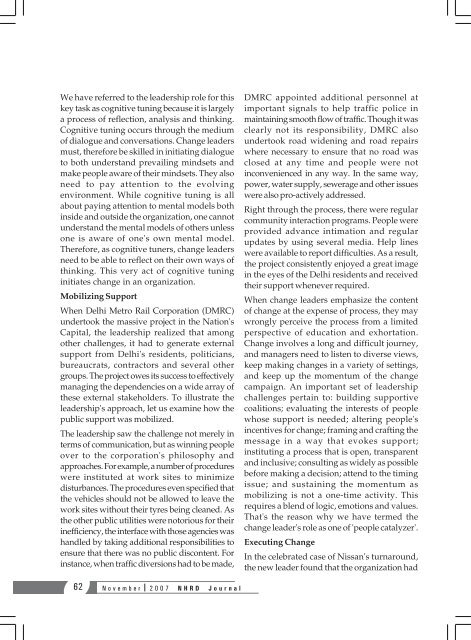NHRD Journal - National HRD Network
NHRD Journal - National HRD Network
NHRD Journal - National HRD Network
Create successful ePaper yourself
Turn your PDF publications into a flip-book with our unique Google optimized e-Paper software.
We have referred to the leadership role for this<br />
key task as cognitive tuning because it is largely<br />
a process of reflection, analysis and thinking.<br />
Cognitive tuning occurs through the medium<br />
of dialogue and conversations. Change leaders<br />
must, therefore be skilled in initiating dialogue<br />
to both understand prevailing mindsets and<br />
make people aware of their mindsets. They also<br />
need to pay attention to the evolving<br />
environment. While cognitive tuning is all<br />
about paying attention to mental models both<br />
inside and outside the organization, one cannot<br />
understand the mental models of others unless<br />
one is aware of one's own mental model.<br />
Therefore, as cognitive tuners, change leaders<br />
need to be able to reflect on their own ways of<br />
thinking. This very act of cognitive tuning<br />
initiates change in an organization.<br />
Mobilizing Support<br />
When Delhi Metro Rail Corporation (DMRC)<br />
undertook the massive project in the Nation's<br />
Capital, the leadership realized that among<br />
other challenges, it had to generate external<br />
support from Delhi's residents, politicians,<br />
bureaucrats, contractors and several other<br />
groups. The project owes its success to effectively<br />
managing the dependencies on a wide array of<br />
these external stakeholders. To illustrate the<br />
leadership's approach, let us examine how the<br />
public support was mobilized.<br />
The leadership saw the challenge not merely in<br />
terms of communication, but as winning people<br />
over to the corporation's philosophy and<br />
approaches. For example, a number of procedures<br />
were instituted at work sites to minimize<br />
disturbances. The procedures even specified that<br />
the vehicles should not be allowed to leave the<br />
work sites without their tyres being cleaned. As<br />
the other public utilities were notorious for their<br />
inefficiency, the interface with those agencies was<br />
handled by taking additional responsibilities to<br />
ensure that there was no public discontent. For<br />
instance, when traffic diversions had to be made,<br />
DMRC appointed additional personnel at<br />
important signals to help traffic police in<br />
maintaining smooth flow of traffic. Though it was<br />
clearly not its responsibility, DMRC also<br />
undertook road widening and road repairs<br />
where necessary to ensure that no road was<br />
closed at any time and people were not<br />
inconvenienced in any way. In the same way,<br />
power, water supply, sewerage and other issues<br />
were also pro-actively addressed.<br />
Right through the process, there were regular<br />
community interaction programs. People were<br />
provided advance intimation and regular<br />
updates by using several media. Help lines<br />
were available to report difficulties. As a result,<br />
the project consistently enjoyed a great image<br />
in the eyes of the Delhi residents and received<br />
their support whenever required.<br />
When change leaders emphasize the content<br />
of change at the expense of process, they may<br />
wrongly perceive the process from a limited<br />
perspective of education and exhortation.<br />
Change involves a long and difficult journey,<br />
and managers need to listen to diverse views,<br />
keep making changes in a variety of settings,<br />
and keep up the momentum of the change<br />
campaign. An important set of leadership<br />
challenges pertain to: building supportive<br />
coalitions; evaluating the interests of people<br />
whose support is needed; altering people's<br />
incentives for change; framing and crafting the<br />
message in a way that evokes support;<br />
instituting a process that is open, transparent<br />
and inclusive; consulting as widely as possible<br />
before making a decision; attend to the timing<br />
issue; and sustaining the momentum as<br />
mobilizing is not a one-time activity. This<br />
requires a blend of logic, emotions and values.<br />
That's the reason why we have termed the<br />
change leader's role as one of 'people catalyzer'.<br />
Executing Change<br />
In the celebrated case of Nissan's turnaround,<br />
the new leader found that the organization had<br />
62<br />
November 2007 <strong>N<strong>HRD</strong></strong> <strong>Journal</strong>
















